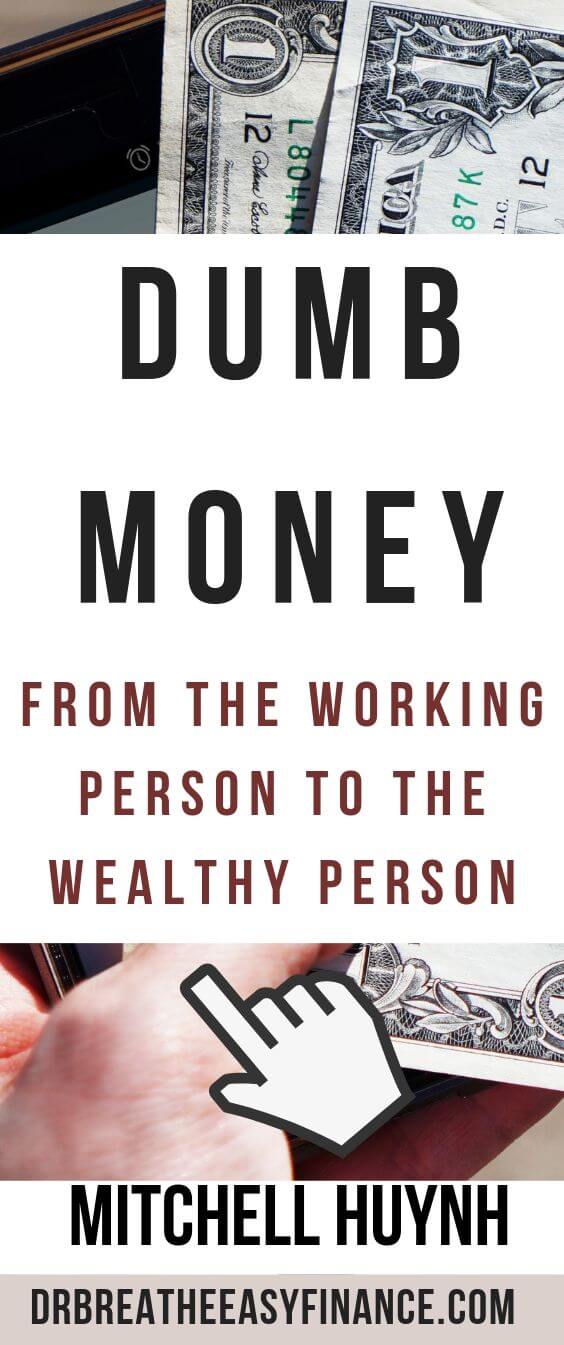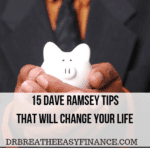Mitchell Huynh, a very good friend of mine recently published a great book on Personal Finance called Dumb Money: From The Working Person to The Wealthy Person.
I am especially happy for him, as we were both part of the UTM breakers, a breakdancing club in undergrad. Its interesting how many of us took to finance. Currently, we are working together in building wealth through real estate property in Ontario, Canada. So when I say I know him well, I mean it.
He currently teaches Personal Finance at The University of Toronto, a course which he created and pitched to the University. The course has amazing reviews from the students and ranks among the best offerings in the Management Department. Mitch has received acclaim from and been featured in the Toronto Star, Maclean’s Magazine, and CPA Canada.
Aside from teaching he is also a director at a financial management company; the host of not just one, but TWO personal finance TV shows, one on Rogers TV called Smart Money, and the other called Finance My Life on Cogeco TV; as well as a condo developer in the Toronto area, currently building a 12 story, 345-unit condo building.
What makes this book special? Precisely because it is the cold hard truth about money, and how to build wealth according to Mitch.
What makes him the expert? Track record. He graduated from his MBA at the Schulich School Of Business in 2014 with a networth of negative (I repeat NEGATIVE) 80 thousand dollars and within four years, he has built his networth to several million dollars as well as amassed a real estate portfolio in the Toronto area worth over $10 million. A very impressive feat for anyone to do, let alone in four years.
If that isn’t enough, both his book and his online course have received a strong endorsement from none other than Shark Tank’s infamous Mr. Wonderful, Kevin O’Leary.
For a price tag of $28.88, this is not only a bargain but a must-read!
Purchase book at amazon below.
You can thank me later!
Speaking to Mitch, you can tell he is extremely passionate about helping people with their finances. It definitely shows in the results of the students who have taken his course. As Maclean’s Magazine reports, one of Mitch’s students only aged 21 has bought two rental properties (and is currently working on acquiring his 3rd) which pay for themselves and generate more income than an entry-level job.
The book takes you through the very basics from bank accounts, debt products, and investment products at the bank levels. This establishes a base of financial knowledge. This is essentially the financial acumen of your average bank advisor. The next section of the book teaches you how to put together an effective financial plan, leaving out all of the frills. He walks you through how to construct an efficient cash flow and balance sheet; how to properly make financial goals; how to make proper projections; and lastly how you can modify your financial plan to reach your goals.
During all of this, Mitch is cognisant not to forget “bullet-proofing” the financial plan so that no matter what happens in life, you will reach your goal of becoming wealthy.
The next few parts are where it becomes interesting. It goes far beyond the regular personal finance teachings. He dives into how to become a business owner and the advantages. As most of us are business owners in our own sense, he outlines a strategy he loves to use to turn taxable income into tax-free income through specialized corporate structuring.
Mitch then moves into what he calls alternative investments – primarily private mortgages, investment properties, and leveraged buyouts. These aren’t your ordinary syndicated private mortgages where the syndicating corporation makes a good chunk of money from your money. He teaches us how to source, manage, and syndicate for ourselves, thereby increasing your return dramatically.
His practical investment property techniques have resulted in 30%-50% year over year returns.
Throughout the book, Mitch emphasizes using the same one dollar to accomplish multiple things, which effectively multiples your money.
It is a great read which imparts practical financial know-how, coupled with anecdotes from Mitch’s life to give some insight on how he was able to build his networth so quickly.
Below is an exclusive excerpt of the introduction of the book, enjoy!

Introduction To Dumb Money
I wasn’t always the financial “genius” as I am often called these days. Mitch Millions, Money Mitch, Financial Ninja, Mitch Deezed are a few of my more common nicknames.
During university (I attended the University Of Toronto Mississauga, where I now teach among other things) and up until about 5 years ago, “the squad” and I were pursuing our dreams of becoming professional breakdancers and touring around the world. (Its true! You can Google us, type “GG Squad” and Much Music – yes, that’s me falling on national television). We did this during university and even after we graduated while I was working as an advisor at Scotiabank. We still believed we would get there.
What we had, was a winner’s mindset which we cultivated during our university days. Train hard; Put in the work; Be the best.
This book and where I am today in life is the result of taking that same mindset and applying it in my daily life.
“If you knew better, you would do better.” I take this saying everywhere I go. I came from the bank industry, where average people gave pretty much the same financial advice to everyone who walked in the door.
That’s when I realized, to do better we must be more discerning about who is eligible to give us advice on “insert topic.” If its finances, what have you done in your own life regarding finances that have set you apart from the average person? What have you done in your client’s lives that set them apart from the average person? What have you done that was so amazing that I should listen to you?
There had to be something more, something out there that could impact people’s financial lives in a more tangible way than what we currently had at the banks.
That realization made me pursue my MBA, in search of more. During my MBA, I had two epiphanies. First, my BHAG (Big Hairy Audacious Goal) was to touch the lives of 5,000,000 people in a positive way. Second, wealth inequality.
How could I combat wealth inequality? I originally created a start-up, which paid our users $5.25/hour for using our phone or desktop application. We accomplished this by funneling ad revenues to our users (the people who watch at the ads). Thus, by giving people money for something they are already doing, I believed I was fighting wealth inequality. That was until we found out that one of the biggest tech companies out there has the rights to patent our ecosystem.
That start-up experience was when I realized I could no longer work for anyone else. I needed to be my own boss.
I decided to join Investors Group and build my wealth management practice. Through educating both my clients and other consultants, I hoped to provide people the financial knowledge to succeed. This was a big gamble, as consulting at Investors Group is a 100% commission-based job, that means, if you don’t sell, you don’t eat. I was able to quickly become one of the top-performing consultants from my first year there, by understanding what the financial industry lacked.
The first few months at Investors Group was TOUGH. I worked long hours and built up my clients quickly, but my hard work wasn’t reflected in my bank account. I studied how Investors Group compensation worked and quickly came to realize that I would need to sell to quite a few families and individuals to make a decent income OR I could sell to a few business owners and high net worth individuals. And so, that is what I did.
I dove deep into how business owners run their businesses and what they need from the financial industry. It came down to tax efficiencies and strategies to create tax-free income over the long term. Surprisingly, very few individuals specialized in this space, primarily top tax lawyers on Bay St. in Toronto who charge upwards of $1000/hour for advice. I learned everything about this niche area of financial planning and began to offer my knowledge as a value add to my business owner and high net worth clients.
I quickly came to realize that everyone could be using these same strategies, except no one was teaching them as there was so much more money to be made in the High Net worth market.
I couldn’t reach enough people working at Investors Group. That’s when I decided to have my own personal finance TV shows. The conversation with my fiancée at the time went like this.
Me: “Baby! Wouldn’t it be awesome if I had my own TV show?!”
Cherie: “Yes, would be really cool but it’s probably very difficult to get your own show.”
I tuned out the 2nd half of her sentence because I was too busy envisioning my show. Instead of one, I got two! One on Rogers TV which I called Smart Money, and one on Cogeco TV called Finance My Life.
I quickly moved up to the role of Director in only 18 months with Investors Group (the fastest move to Director in the company – see the Negotiations section of my book for how I pulled this off).
I still wasn’t satisfied with the impact I was making. My next crazy idea was to become a professor teaching personal finance at the top higher education institution in Canada – none other than my alma mater, The University of Toronto.
The conversation with my fiancée went like this:
Me: “Hey baby! What do you think of me becoming a Prof at U of T?!”
Cherie: “Why are you copying me?” (back story – she is an elementary school teacher at the Toronto District School Board)
Me: “LoL kk”
And so, I designed the course curriculum, contacted a friend I had working in the Management Department at that time to pitch the idea. They did a quick survey to assess demand and found that quite a few students would be interested in taking it. Armed with that information, I sat down with the director of the Management Department to discuss.
And here we are 2 years later, with each semester me teaching 150 students for a total of 300 students per year! Hopefully, there is a trickle-down effect and my students teach their parents and loved ones.
Shortly after getting the position at UTM, I stepped down from my role of Director at Investors Group as I found it restricting for both myself and my clients. For my clients, I could only offer Power Financial products as Power Financial Corp was the mother company of Investors Group which also owned Canada Life, Great-West Life, Mackenzie Investments, Putnam Investments, Wealth Simple, etc. For myself, Investors Group greatly discourages any outside activity other than working for them. As you will read later in the book, you want to not only diversify your investments but also, your income.
I moved into the role of Director at Experior Financial Group. A dynamic new financial management firm with great training and leadership. My knowledge allowed me to garner the respect of the leadership and I became the “Go To” person for the High Net worth and Business Owner clientele of the firm (read How to become the key person section) as well as build a strong team of active advisors across Canada.
This allowed me the flexibility to go to the office when I wanted, only needing to see my clients and submit business.
This was pivotal, as I was able to generate more than a six-figure income on part-time hours, thus allowing me to build my real estate portfolio, other lines of business, and of course my human capital.
There are so many opportunities out there that we miss every single day. Opportunities to build our cash flow, net worth, human capital etc. These opportunities are in front of us every day all the time. However, because we are so busy and focused on working for our “bosses” and the responsibilities of every day lives, our brain has been trained to ignore these opportunities.
There is always so much going on around us (lights, sounds, movements). Our brain has been trained to cut out things that are not important. If our brain was to analyze and dissect all these stimuli, we would go crazy.
Our brain is trained to only react to things that we tell it are important. Everything else, it will tend to ignore. You will notice this when you buy a new car. Before you got the car, it was a unique good-looking car. After you got the car, everyone seems to have one. That’s because now, your brain is trained to recognize the car because it is important to you.
That’s the same with opportunities. This book will teach you what is out there and how to use it, as I have. Once you tell your brain to start looking for these things, suddenly, they will be everywhere for you to pick and choose. Combine that with being a key-person and the results will be endless!
With these new opportunities will come new challenges. Don’t be afraid to take them head-on. As a species, we have evolved to survive. One way to survive is to preserve energy. Brain activity consumes a lot of energy. You will notice this during days in which you may not have done much physically, but you were mentally and emotionally stressed out and at the end of that day, your body was also totally drained.
Through evolution, we have evolved to be lazy and preserve energy by limiting our brainpower. We are naturally lazy. If given the chance, we will more likely than not pick the easier path. The path of least resistance. Our brain is the same. If you believe that there is no solution to something, your brain will automatically shut down and stop thinking about that issue.
Our brain is fascinating and powerful. But it is only as strong as you are. Our brain doesn’t know what is true or untrue. Therefore, if you tell your brain something is doable, your brain will automatically try to figure out a solution. Trust me, there is a solution to everything – but not if you’ve told your brain to give up! You will notice this, when you bump into someone you haven’t seen in a long time. You’ve forgotten their name, but deep down, you know without a doubt that you know their name. A day, or maybe a week later, their name will pop into your head. That’s the power of your brain believing there is a solution. It will continue working on the issue subconsciously without you noticing.
Don’t be afraid to take on new opportunities, because you will figure out a way to execute successfully. Believe that you can, and you will.
Don’t be afraid to take on new opportunities, because you will figure out a way to execute successfully. Believe that you can, and you will. Share on X
A far-fetched dream of mine was to build a “GG (that’s the name of my squad) Compound”, which would be a private neighbourhood in which the entire squad and our families would live. This was something I thought about 10 years ago. Today, among other things I am a condo developer, developing a 12 story, 345-unit condo in Toronto. Building that GG Compound is not such a far-fetched dream after all!
Our conversation went like this:
Me: “Hey baby! What if I build condos?”
Cherie: “You build something? roflroflroflmao”
(backstory – I am the least handy person I know, don’t call me to help assemble IKEA furniture!)
How in the world did I go from a financial advisor to a TV show host, to a university professor, to a director of a wealth management firm, to owning multiple rental properties in Toronto, to a condo developer in Toronto in 4 years all at the same time? Unyielding belief in myself.
I now have built a real estate portfolio worth well over 8 figures in the Toronto area (and that’s not even my full-time job!). I like to say I have many part time jobs (which I do, see all the above and add full time husband and doggy daddy to two dogs with our first baby on the way).
The key to building multiple sources of income, is having all your sources of income build on each other. Each one of my “side hustles” are related to each other. Therefore, as I develop one of them, all the others increase in value as well. So, by spending 1 hour working on one of them, I am actually producing 5 hours of benefit (assuming I have 5 part-time side hustles).
This is the same concept involved in our financial planning and wealth building. You never want to use one dollar as one dollar. You always want to find a way to use that same one dollar to do several things. If you can, you’ve effectively created several dollars from that one dollar.
Sir Isaac Newton said it best “If I have seen further it is only by standing on the shoulders of giants.” Now, I am no giant, as I am still on my way to the goal of $100M, which I should reach in 10 years if I continue to move at this pace.
I do hope after reading this book and applying the concepts you’ve learned you will achieve similar if not greater success than I have.
Dedicate yourself to reading this book and understanding the concepts. I promise you the rewards will be limitless. The beginning portion of the book will be a bit dry, but persevere, trust me. I need to take you back to square one, to build up your mind so that it can more effectively absorb the later sections of the book.
Hope you enjoyed that exclusive excerpt of the introduction of the book! If you would like to read more, you can purchase the book on Amazon. Let me know if you enjoyed the book as much as I did!
There you have it. I enjoyed the book. I am sure you will too.
I am a pulmonary and critical care doctor by day and personal finance blogger/debt slaying ninja by night.
After paying off close to $300,000 in student loan debt in less than 6 months into my real job, I started on a mission to help others achieve the same. There is no magic to this than to strap up and get it done. Some of the ways we achieved this include side hustle, budgeting, great negotiation skills, and geographical arbitrage.
When I was growing up, common knowledge in Nigeria is that there is one thing you cannot trust anyone else with, and you guessed it – your money.
Being frugal came easily to me based on my background. However, the concept of building wealth did not solidify in my mind until when I finished medical school. I wish I knew what I know now when I was 14. Still, I don’t know enough and I am constantly learning to improve my knowledge.
My goal is to reduce financial illiteracy among young professionals. I am catering to the beginners – babies and toddlers in financial literacy.








Leave a Reply